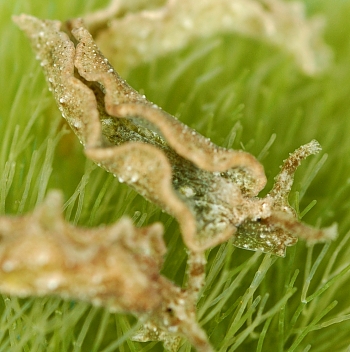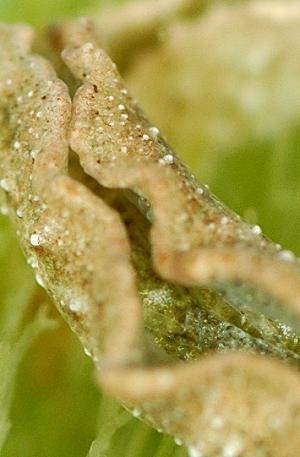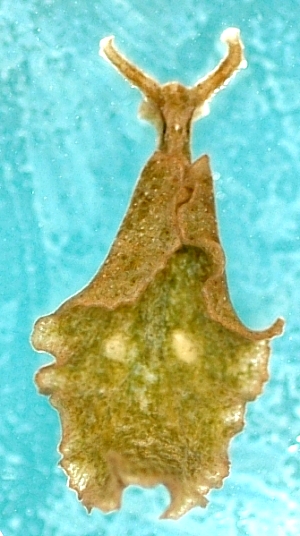Elysia patina from Florida
August 25, 2006
From: Sidney Pierce

Hi Bill
Attached are a couple of pictures (taken by my post-doc, Nick Curtis and colleague Ray Martinez) of one of several specimens of an Elysia that crawled out of Penicillus capitatus that I collected at Sunset Beach, Tarpon Springs, FL. They were either juveniles or an unnoticed egg mass when collected. They appeared in our lab aquaria a couple of weeks after the algae had been collected. I was collecting the algae for food for Elysia clarki, which does not occur as far north as Tarpon Springs. I've seen these guys before, but never paid too much attention to them as they are too small and too few for us to work on. We always have glibly identified them as Elysia papillosa. However, I'm wondering about that identification. I've looked at Verrill's original description (Verrill is a hero to me, by the way) and the Tarpon Springs specimens do not match his brief description of E. papillosa very well (except that they do swim!!) nor his drawing-even assuming some artistic license-(nor the Marcus' cartoons) nor do they look much like some of the pictures identified as E. papillosa on the Forum, especially some of those from the Bahamas. On the other hand, other Forum photos, in the E. papillosa group (eg. Anna Bass', K. Archer's, maybe Montoya's-from various sites in the Bahamas and Caribbean) look just like the Tarpon Springs slugs. Since Verrill's description of E. papillosa was based on ("rare") specimens from Bermuda and seems to be a closer match to some of the Bahamas photos-I initially thought the Tarpon Springs slugs might be a new species. However, I was watching some swim the other day and as the parapodia flailed away, two "gametolytic vesicles" were uncovered on the dorsal surface (see the photo). I have no idea what gametolytic vesicles are in a functional sense, but there are not many species of Elysia that have them-and E. papillosa does not as near as I can tell. Of those species that seem to have that structure, only the elusive E. patina, which Marcus described from a single specimen collected in the Keys, seems to fit (Jensen and Clark (1983) also reported collecting some at Key Largo, subsequent to Marcus' (1980) description, mostly without comment). I agree with your comments about the problems caused by describing a new species on the basis of a single, preserved specimen, which is exactly what Marcus did in this case. But maybe she was right?? What do you think??
By the way, these guys do eat and grow very rapidly on Penicillus capitatus (which is the alga in the picture) and, if they have a chloroplast symbiosis, it does not last long-maybe a week or two. You and others have noted that Kerry Clark predicted that E. papillosa was likely composed of more than one species - maybe E. patina is part of the confusion?? Or maybe I'm confused.
Locality: Sunset Beach, Tarpon Springs, just subtidal, Florida, USA, Gulf of Mexico, many times throught the year, on Penicillus capitatus. Length: 5-7mm. Photographer: Nick Curtis and Ray Martinez.
Skip
pierce@cas.usf.edu



Dear Skip,
As I said earlier [message #7929 ] I am sure there will be many wasted hours spent trying to determine the indentity of E. patina. I can't see why it was necessary to give one preserved specimen a scientific name. Your animals may be her E. patina but until the Elysia species of the Caribbean is reviewed as a group, rather than one by one, I suspect confusion will continue. Concerning "gametolytic vesicles" [see two white structures in photo alongside] I assumed these are temporary structures produced by species which fertilise each other by hypodermic injection. Rather than use a female vaginal opening, ther are some species of sacoglossan which have a stylet on the tip of the penis with which they inject their sperm into the partner, straight through the body wall. In some species there seems to be a favourite spot in which to inject, while in others it seems to be fairly random. After the sperm is injected inot the body cavity, a sac [the gametolytic vesicle] forms around the sperm mass, but from there just how the sperm gets to the unfertilise eggs is a bit of a mystery to me. Perhaps Kathe can enlighten us.
However since I thought the gametolytic vesicles were temporary structures able to be produced when neede, at different places, they don't seem to be a good taxonomic character. Perhaps in some species they always form at the same place?
I was going to put your species on an 'unidentified page' but I think I wiull put it on the E. papillosa page, so that it remains part of the discussion.
Best wishes,
Bill Rudman
Related messages
-
Triad rhinophores of Elysia
From: Deng Yan Zhang, May 12, 2009 -
Re: Elysia patina from Florida
From: Kathe R. Jensen, August 26, 2006 -
Elysia papillosa from the Bahamas
From: Anne DuPont, September 12, 2005 -
Re: Elysia papillosa from Cape Verde Islands
From: Kathe R. Jensen, March 5, 2004 -
Elysia papillosa from Southern Bahamas
From: Marina Poddubetskaia, March 5, 2004 -
Elysia papillosa - algal food
From: Marina Poddubetskaia, March 5, 2004 -
Elysia papillosa from Northern Bahamas
From: Marina Poddubetskaia, March 5, 2004 -
Elysia papillosa from Cape Verde Islands
From: Gérard Breton, August 26, 2003 -
Re: Elysia from Florida
From: Kathe R. Jensen, January 18, 2002 -
Re: Elysia from Florida
From: Colin Redfern, January 17, 2002 -
Re: Elysia from Florida
From: Kathe R. Jensen, January 13, 2002 -
Elysia from Florida
From: Kathleen Archer, January 12, 2002 -
Elysia papillosa from Florida
From: Anna L. Bass , January 13, 2001 -
With regards to Elysia papillosa
From: Phanor Montoya, October 16, 2000 -
Re: Elysia from Colombia
From: Kathe R. Jensen, October 16, 2000 -
Elysia from Colombia
From: Phanor Montoya, October 8, 2000
